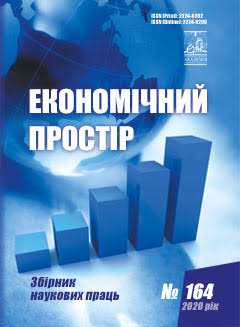WAYS OF FORMATION OF CORPORATE REPUTATION IN THE CONTEXT OF THE OBJECTIVES OF REPUTATION MANAGEMENT
Abstract
The key drivers of sustainable development in today's business environment are the recognition of the company and its positive perception among stakeholders, which is ultimately accompanied by profitability and strengthening of competitive positions in the relevant market. An important role in this context is played by the company's reputation, the importance of which is growing in the information economy and publicity of business processes. Of course, such circumstances require management to constantly review existing methods of managing the company's activities, including the management of reputational assets. A well-founded, clearly set goal of reputation management and a developed sequence of tasks for managing the company's reputation assets will provide an effective mechanism for constructing and maintaining a positive reputation. The peculiarity of the proposed sequence of tasks of reputation management is to take into account the opinions and expectations of the business environment, on the basis of which, as is known, the «halo» of the company's reputation is formed. In other words, the company's reputation management process is based on a behavioral-oriented approach, which provides an opportunity to coordinate the company's behavior in accordance with the expectations of the business environment. It is proposed that one of the tasks to determine the reputation characteristics of the enterprise and compare them with the priorities and expectations of key stakeholders, which will ultimately determine the effective ways to communicate with them. It has been established that the company's positive reputation among key stakeholders is formed in various ways and means of disseminating information. It is known that in practice there are different ways of disseminating information to build the desired reputation, each of which has its own characteristics. Of course, the rationale for choosing the most effective ways to disseminate information should be consistent with the goal and outlined tasks of reputation management, based on available resources and existing communication channels. The scientific value of the study lies in supplementing the theoretical and methodological basis of reputation management, in particular in terms of defining clear tasks of reputation assets management and choosing the most effective ways to disseminate information to construct the desired reputation.
References
Dewar C., Keller S., Sneader K., Strovink K. The CEO moment: Leadership for a new era. McKinsey Quarterly. URL: https://www.mckinsey.com/featured-insights/corporate-purpose (дата звернення: 27.11.2020).
Golin A. Legends of Public Relations. Progressions. URL: https://progressions.prsa.org/index.php/2014/01/20/legends-of-public-relations-alvin-golin/ (дата звернення: 24.11.2020).
Nakra P. Corporate Reputation Management: «CRM» with a Strategic Twist. Public Relations Quarterly. 2000. Vol. 45. № 2. P. 35–42.
Hutton J.G. The definition, dimensions and domain of public relations. Public Relations Review. 1999. Vol. 25. № 2. P. 199–214.
Finn D.W, Baker J., Marshall G.W., Anderson R. Total quality management and internal customers: measuring internal service quality. Journal of Marketing Theory and Practice. 1996. Vol. 4. № 3. P. 36−51.
Ewen S. PR! : a social history of spin. New York: Basic Books, 1996. 496 p.
Shkromyda V. Disputed aspects of the reputation management implementation. Journal of Vasyl Stefanyk Precarpathian National University. 2020. Vol. 7. № 3. P. 60−67. DOI: https://doi.org/10.15330/jpnu.7.3.60-67.
Fombrun C.J. Reputation: realizing value from the corporate image. Boston, MA: Harvard Business School Press, 1996. 441 p.
Shamma H.M. Toward a Comprehensive Understanding of Corporate Reputation: Concept, Measurement and Implications. International Journal of Business and Management. 2012. Vol. 7. № 16. P. 151−169.
Bromley D.B. Psychological aspects of corporate identity, image, and reputation. Corporate Reputation Review. 2000. Vol. 3. № 3. P. 240–252.
Dewar C., Keller S., Sneader K., Strovink K. (2020) The CEO moment: Leadership for a new era. McKinsey Quarterly. Available at: https://www.mckinsey.com/featured-insights/corporate-purpose (accessed 27 November 2020).
Golin A. (2014) Legends of Public Relations. Progressions. Available at: https://progressions.prsa.org/index.php/2014/01/20/legends-of-public-relations-alvin-golin/ (accessed 24 November 2020).
Nakra P. (2000) Corporate Reputation Management: «CRM» with a Strategic Twist. Public Relations Quarterly, vol. 45, no. 2, pp. 35–42.
Hutton J.G. (1999) The definition, dimensions and domain of public relations. Public Relations Review, vol. 25, no. 2. pp. 199–214.
Finn D.W, Baker J., Marshall G.W., Anderson R. (1996) Total quality management and internal customers: measuring internal service quality. Journal of Marketing Theory and Practice, vol. 4, no. 3, pp. 36−51.
Ewen S. (1996) PR! : a social history of spin. New York: Basic Books.
Shkromyda V. (2020) Disputed aspects of the reputation management implementation. Journal of Vasyl Stefanyk Precarpathian National University, vol. 7, no. 3, pp. 60−67. DOI: https://doi.org/10.15330/jpnu.7.3.60-67.
Fombrun C.J. (1996) Reputation: realizing value from the corporate image. Boston, MA: Harvard Business School Press.
Shamma H.M. (2012) Toward a Comprehensive Understanding of Corporate Reputation: Concept, Measurement and Implications. International Journal of Business and Management, vol. 7, no. 16, pp. 151−169.
Bromley D.B. (2000) Psychological aspects of corporate identity, image, and reputation. Corporate Reputation Review, vol. 3, no. 3, pp. 240–252.



